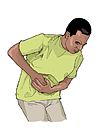Video:Septicemic plague
| Septicemic plague (Tutorial) | |
|---|---|
| Commons / NC | |
| Steps for video creation | |
| Step 1 | Preview my changes (10 sec) |
| Step 2 | Upload to Commons (10 min) |
Description
Septicemic plague is one of the three forms of plague, and is caused by Yersinia pestis, a gram-negative species of bacterium. It is a systemic disease involving infection of the blood, and is most commonly spread by bites from infected fleas .[1]Starting antibiotics early is a first step in treating septicemic plague in humans.[2][3]

Presentation
The usual symptoms are the following:abdominal pain, bleeding due to blood clotting problems, diarrhea, fever, nausea, and vomiting.[4]

Cause
Human Yersinia infections most commonly result from the bite of an infected flea or occasionally an infected mammal. If the bacteria happen to enter the bloodstream rather than the lymph or lungs, they multiply in the blood, causing sepsis. In septicemic plague, bacterial endotoxins cause disseminated intravascular coagulation, where tiny blood clots form throughout the body, commonly resulting in localised ischemic necrosis, tissue death from lack of circulation and perfusion.[5][6][7]

Mechanism
The pathogenesis of Y. pestis infection of mammalian hosts is due to several factors, including an ability of these bacteria to suppress and avoid normal immune system responses such as phagocytosis and antibody production. Flea bites allow for the bacteria to pass the skin barrier. [8] Many of the bacteria's virulence factors are antiphagocytic in nature. Two important antiphagocytic antigens, named F1 and LcrV, are both important for virulence.[9] These antigens are produced by the bacterium at normal human body temperature. [10]

Diagnosis
In terms of the diagnosis for Septicemic plague we find that a physician will ask about the medical history and possible sources of exposure.[11] The following possible test to evaluate the individual could include:blood samples (to detect antibodies)[12] and culture samples.[2]

Differential diagnosis
The differential diagnosis for Septicemic plague is Tularemia as well as Cat scratch disease.[6]

Management
Starting antibiotics early is a first step in treating septicemic plague in humans. One of the following antibiotics may be used: streptomycin, gentamicin, doxycycline or chloramphenicol.[2][3][6]

Epidemiology
Plague cases were massively reduced during the second half of the 20th century, but outbreaks still occurred, especially in developing countries. Between 1954 and 1997, human plague was reported in 38 countries, making the disease a re-emerging threat to human health.[13] Between 1987 and 2001, almost 37 thousand confirmed cases of plague with two thousand eight hundred twenty seven deaths were reported to the World Health Organization.[14]

History
Alexandre Yersin is credited with discovering the bacterium responsible for causing Septicemic plague. In 1894, Yersin identified the bacterium as Yersinia pestis.[15][16]

References
- ↑ Dillard, Robert L.; Juergens, Andrew L. (2024). "Plague". StatPearls. StatPearls Publishing.
- ↑ 2.0 2.1 2.2 Yang, Ruifu (January 2018). "Plague: Recognition, Treatment, and Prevention". Journal of Clinical Microbiology. 56 (1): e01519-17. doi:10.1128/JCM.01519-17. PMC 5744195. PMID 29070654.
- ↑ 3.0 3.1 Nelson, Christina A.; Meaney-Delman, Dana; Fleck-Derderian, Shannon; Cooley, Katharine M.; Yu, Patricia A.; Mead, Paul S. (16 July 2021). "Antimicrobial Treatment and Prophylaxis of Plague: Recommendations for Naturally Acquired Infections and Bioterrorism Response". MMWR. Recommendations and reports: Morbidity and mortality weekly report. Recommendations and reports. 70 (3): 1–27. doi:10.15585/mmwr.rr7003a1. ISSN 1545-8601. Archived from the original on 9 February 2023. Retrieved 23 June 2023.
- ↑ "Plague: MedlinePlus Medical Encyclopedia". web.archive.org. 5 July 2016. Retrieved 23 May 2024.
- ↑ Barbieri, R.; Signoli, M.; Chevé, D.; Costedoat, C.; Tzortzis, S.; Aboudharam, G.; Raoult, D.; Drancourt, M. (16 December 2020). "Yersinia pestis: the Natural History of Plague". Clinical Microbiology Reviews. 34 (1): e00044–19. doi:10.1128/CMR.00044-19. ISSN 1098-6618. PMC 7920731. PMID 33298527.
- ↑ 6.0 6.1 6.2 "Plague - Symptoms, Causes, Treatment | NORD". rarediseases.org (in español). Archived from the original on 2 July 2023. Retrieved 17 June 2023.
- ↑ "Plague: Background, Pathophysiology, Epidemiology". Medscape. 16 October 2021. Archived from the original on 24 June 2022. Retrieved 1 July 2023.
- ↑ Lathem WW, Price PA, Miller VL, Goldman WE (January 2007). "A plasminogen-activating protease specifically controls the development of primary pneumonic plague". Science. 315 (5811): 509–13. Bibcode:2007Sci...315..509L. doi:10.1126/science.1137195. PMID 17255510. S2CID 39881239.
- ↑ Collins, Frank M. (1996). "Pasteurella, Yersinia, and Francisella". Medical Microbiology (4th ed.). University of Texas Medical Branch at Galveston. ISBN 978-0-9631172-1-2. Archived from the original on 2021-05-06. Retrieved 16 June 2023.
- ↑ Salyers AA, Whitt DD (2002). Bacterial Pathogenesis: A Molecular Approach (2nd ed.). ASM Press. pp. 207–212.
- ↑ Nikiforov, Vladimir V.; Gao, He; Zhou, Lei; Anisimov, Andrey (2016). "Plague: Clinics, Diagnosis and Treatment". Advances in Experimental Medicine and Biology. 918: 293–312. doi:10.1007/978-94-024-0890-4_11. ISSN 0065-2598.
- ↑ "Diagnosis and treatment of plague | CDC". Centers for Disease Control and Prevention. 26 November 2019. Archived from the original on 5 April 2022. Retrieved 18 June 2023.
- ↑ Xu, Lei; Liu, Qiyong; Stige, Leif Chr.; Ben Ar, Tamara; Fang, Xiye; Chan, Kung-Sik; Wang, Shuchun; Stenseth, Nils Chr.; Zhang, Zhibin (2011). "Nonlinear effect of climate on plague during the third pandemic in China". Proceedings of the National Academy of Sciences. 108 (25): 10214–10219. Bibcode:2011PNAS..10810214X. doi:10.1073/pnas.1019486108. PMC 3121851. PMID 21646523.
- ↑ Shahraki, Abdolrazagh Hashemi; Carniel, Elizabeth; Mostafavi, Ehsan (2016). "Plague in Iran: its history and current status". Epidemiology and Health. 38: e2016033. doi:10.4178/epih.e2016033. PMC 5037359. PMID 27457063.
- ↑ "Alexandre Yersin, the man who discovered the bacterium responsible for the plague". Institut Pasteur. 24 October 2017. Retrieved 27 May 2024.
- ↑ "Plague (Black Death) bacterial infection information and facts". Science. 6 July 2020. Retrieved 27 May 2024.